|
[ UrbanRail.Net ] [ Europe ] [ Americas ] [ Asia ] [ Africa ] [ Oceania ] [ News ] [ Books ] [ Links ] |
|
STOCKHOLM
|
| Sweden |
| System | |
|
Sweden's capital has probably one of the best public transport systems in Europe, especially if you look at the total length of rapid rail (T-bana, commuter rail and light rail lines) for a relatively low number of inhabitants, only about 800,000 in the city of Stockholm, although the whole metropolitan area (Stockholms län) has about 2 million. The city is situated on various islands which makes city transport a special enterprise. The Stockholm T-bana is also considered to be one of the most beautiful metro systems in Europe, especially the newest line (blue) is a real art gallery. Stockholm's tunnelbana is 108 km long (62 km are underground) with 100 stations. From 1998 most trains have been replaced by the new Vagn 2000. The Stockholm Tunnelbana is operated on the left.
|
|
| Green Line (Gröna Linjen) | |
|
Route
T17: Åkeshov (Odenplan in the evenings) - Skarpnäck
|
|
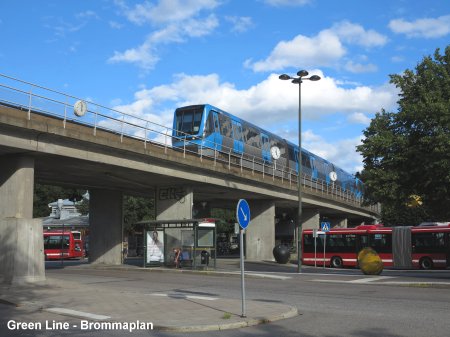
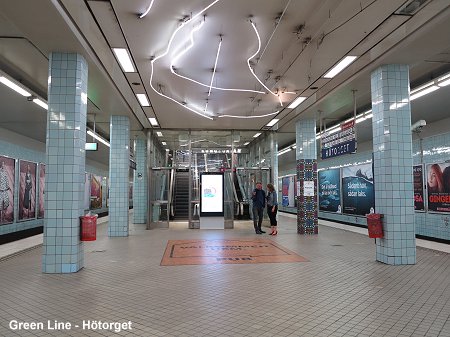
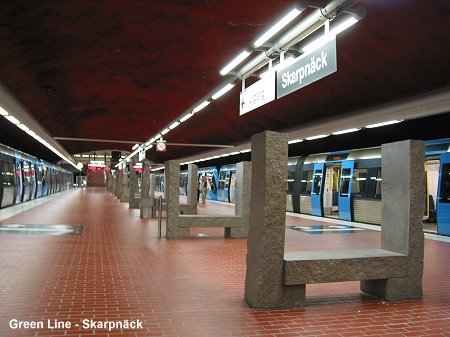 |
|
| Red Line (Röda Linjen) | |
|
Route
T13: Norsborg - Ropsten -
Hissbanan - a rubber-tyred funicular linking Liljeholmen
metro station to the Nybohov neighbourhood. |
|
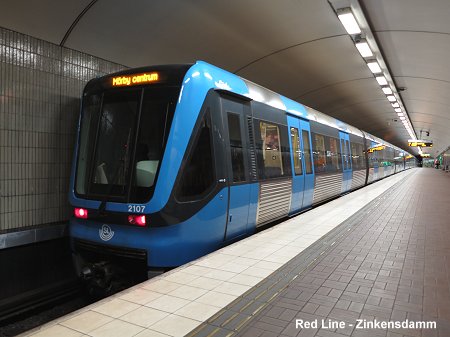
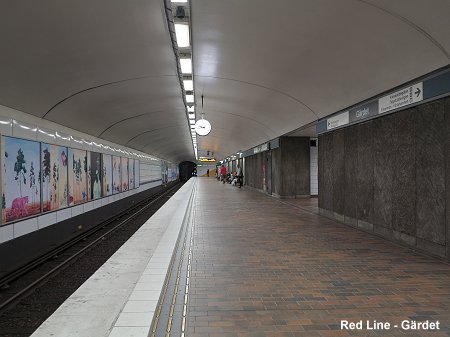
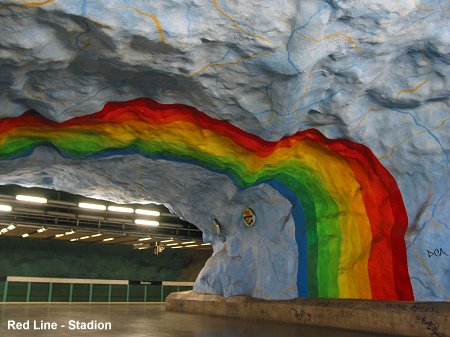 |
|
| Blue Line (Blå Linjen) | |
|
The same year the Red Line was finished the blue line opened its first segment. This line is almost entirely underground (except Kista station) and all stations were built in rock at a depth of 20-30m. All of these stations boast a great design by different artists. Due to the deep alignment the line is not very busy with inner-city traffic, most passengers board the trains at T-Centralen to go to the northwestern suburbs. Along the surface strech of the Akalla branch another station, Kymlinge, was built but never opened. It will probably never open as it lies in a now protected area. The Blue Line operates two lines: Route
T10: Kungsträdgården - Hjulsta Vreten
renamed Solna strand on 18 Aug 2014 |
|
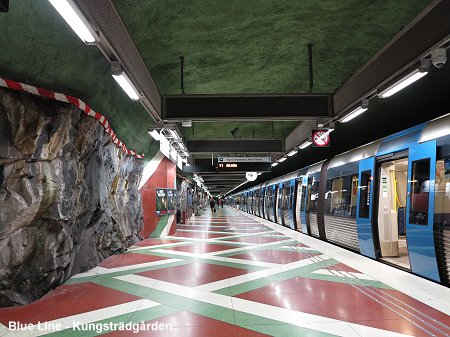
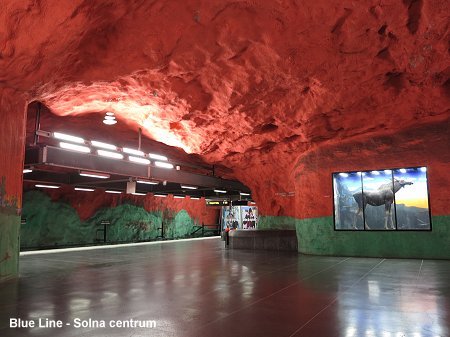
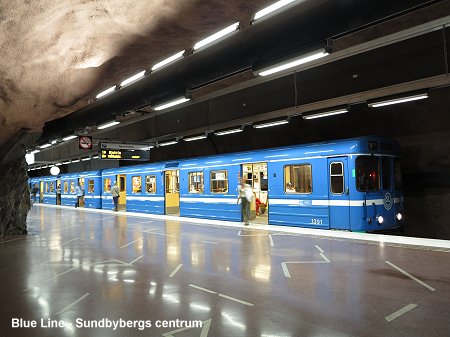
|
|
| Tunnelbana History | |
|
01
Oct 1950: Slussen - Hökarängen Green
Line (South) 09 Jan 2006: Årstaberg station on Pendeltåg line added |
|
|
Projects |
|
|
The T-bana is being extended from Odenplan north to Hagastaden and Arenastaden/Södra Hagalund (2028). Initially promoted as the Yellow Line it was eventually classified as a branch off the Green Line in May 2023. The Blue Line had long been planned to be extended from Kungsträdgården via Skepsholmen to Slussen and further on to Nacka in the east. In 2014 a more direct route via Sofia was chosen, with a branch to Gullmarsplan to connect today's Hagsättra Green Line branch (2030). In the northwest, a 2-station extension from Akalla to Barkarby railway station is also under construction (2026). Find out more about these projects here! Long-term projects: 1) Underground link from Fridhemsplan via Liljeholmen to Älvsjö -the new Yellow Line (8 km, 6 stations). 2) Roslagsbana will get an underground extension from Universitet via Odenplan to T-Centralen, while Stockholm East station will be abandoned. |
|
| Tram & Light Rail | |
|
2) Lidingöbanan (L21) - a single-track light rail line linking the southern part of Lidingö Island to Ropsten station - reopened on 24 Oct 2015 after upgrading, will eventually be linked to Spårväg City. 3) Nockebybanan (L12) - the last of the former rapid tram lines, now operated with modern rolling stock together with the Tvärbanan. Cross-platform interchange with Tunnelbana at Alvik. 4) Tvärbanan (L30/31) - a semi-circular light rail line (modern tram), which opened in June 2000 from Gullmarsplan to Alvik (9.4 km). In 2002, it was extended towards the east to Hammarby Sjöstad and Sickla Udde on the eastern side of the Sickla canal (2.4 km). Then in 2013, it was extended from Alvik to Solna centrum (5.6 km, with an 800 m tunnel just north of Alvik), and to Solna railway station in 2014 (1 km). A 600 m extension to Sickla station on the Saltsjöbanan completed the 18 km route of what is now line 30 (formerly 22) on 2 Oct 2017. The first section of a northwestern 8 km branch to Kista and Helenelund was scheduled to open to Bromma flygplats on 13 Dec 2020 (line 31) but was delayed until 16 May 2021, while the rest continues under construction. [Project website] Visit our dedicated page about Trams & Light Rail in Stockholm!
|
|
| Other Rail Transport in Greater Stockholm | |
|
Apart from the Tunnelbana and the light rail lines, Stockholm has several other suburban railways: 1) Pendeltåg (lines 40-48) - commuter rail line crossing the city north/south and with two branches on either side. Since 10 July 2017, Pendeltåg trains have been running through a new tunnel under the city centre (Citybanan) with stations at Stockholm City (interchange with T-centralen) and at Odenplan. Citybanan Gallery 2) Saltsjöbanan (lines 25 & 26) - a suburban railway, opened in 1893 and electrified in 1913, leaving from Slussen and serving the eastern suburbs (Nacka). 3) Roslagsbanan (lines 27-29) - 891mm gauge suburban network, opened in 1888 and electrified in 1895, leaving next to Tekniska Högskolan station and serving the Täby area northeast of Stockholm.
|
|
|
|
|
| Links | |
|
SL - Storstockholms Lokaltrafik (Official Site) MTR Stockholm (Tunnelbana Operator) Region Stockholm - Transport Projects Stockholms Tunnelbana at Wikipedia Many photographs and links by Leif Spångberg Rail News from Sweden (Svenska Järnvägsklubben - incl. Tunnelbana) Spårvägsmuseet (Tram Museum) Stockholm Trams at UrbanRail.Net Citybanan Gallery at UrbanRail.Net Read your webmaster's personal impressions on the different Stockholm urban rail systems (Aug 2013) |
|
| Books | |
|
Robert Schwandl: Metros in Scandinavia. - 2004, ISBN 978-3-936573-04-6 Björn Alfredsson, Roland Berndt & Hans Harlén: Stockholm under : 50 år - 100 stationer . - Published for Stockholm metro's 50th birthday in 2000. Brombergs - ISBN 9176088324 En värld under jord : färg och form i tunnel... Art on the underground. - Stockholmia Förlag, 2000 - ISBN 9170311072 |
|
2004 © Robert Schwandl - UrbanRail.Net